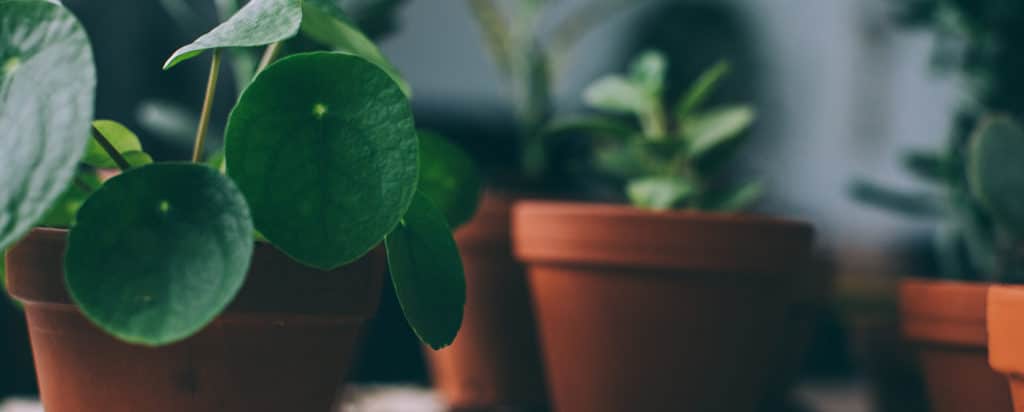
pilea
aka chinese money plant, pilea peperomiodes, friendship plant, pancake plant, coin plant
Just look at those bright green coin-shaped leaves! So money. This plant is a symbol of good fortune and prosperity, and a popular housewarming gift. Description: adorable round leaves / very easy propagation / known as money plant and friendship plant / southern china / humid subtropical
variations
light
bright, but not direct sun
Loves bright light or even partial shade. Direct sunlight can give it a sunburn. Partial shade encourages Pilea to grow larger leaves.
water + feeding
allow top inch to dry between watering
Allow the top inch to dry out before Don’t overwater. Feed biweekly in Spring and Summer.
toxic
safe-ish
Generally safe for pets… but can cause vomiting and nausea if consumed in large amounts.
location
flexible
Adapts to average indoor temperatures. Dislikes cold and drafts. Choose a bathroom or kitchen to give it extra humidity.
humidity
loves it
Pileas like it humid. Mist them regularly or put them in a bathroom or kitchen.
size
small buddy
Kept indoors, Pilea will grow about a foot wide and a foot tall.
pro tip
rotate on the regular
These plants naturally grow towards the sun. Rotate your Pilea when you water it, to promote balanced, even growth.
fun fact
also call the friendship plant
Because Pilea naturally self-propagates, it’s fun and easy to share with friends and family. A housewarming gift extraordinaire.


beyond the basics
-
soil & potting
This plant likes a light, well-draining soil like Miracle-Gro Cactus, Palm and Succulent Potting Mix. Or add some potting sand or perlite to regular potting soil. Your pot must have good drainage and don’t let Pilea sit in water. If you see water collecting in the drainage tray, dump it.
-
when to repot
Repot every 1 to 2 years in the Spring, especially with younger plants. Increase pot by 2 inches every time. If dealing with a more mature, fully grown plant you can just replace the top few inches of soil.
-
propagation
So easy, because Pilea is self-propagating. It creates tiny offshoots also known as ‘pups’. You can leave them on the plant, or create a new one. Wait until your Pilea pup is at least a few inches tall. Gently dig under the pup and cut (or gently pull) the plant free, ensuring you get roots. Put the pup in some water to grow stronger roots, or plant directly in soil. You have a new mini Pilea that makes a perfect gift!
-
pest control
Pileas are bug resistant, but pests are still possible. Inspect under the leaves when doing your regular dusting & cleaning. Check out our Pest control section in Plant 101 for how to identify and deal with pests on your plant!

troubleshooting
-
leaves curved in, or out?
Light and water are incorrect. If the leaves are curled inwards, your Pilea is probably dehydrated. It’s not getting enough water, or it’s getting too much sun. On the flipside, If the leaves are curled outwards it’s probably too much water or not enough light. Check your soil before watering and ensure the top two inches of soil are dry before watering. Time between watering varies by plant and how much light they’re getting.
-
leaves turning yellow or dropping off?
Where are they yellowing? If only the bottom leaves are yellowing and dropping, there’s no problem. That’s normal Pilea behaviour. But If the whole plant is yellowing, you’re probably overwatering. When doing your watering routine, make sure the top 1 to 2 inches of soil are dry before watering.
-
leaves facing in one direction?
Rotate your plant! Pilea’s love to grow towards the sun. This can cause them to become one side heavy or grow unevenly. You should remember to turn your plant every time you water to allow the plant to grow evenly.
-
mold on the surface soil?
Overwatering, too little time between watering. Mold (and even mushrooms) growing on your soil is not a direct threat. But it IS a sign of overwatering. Root rot can follow if not addressed. Water less frequently and make sure you let the top two inches of soil fully dry before watering. Ensure you have proper drainage. If things look really moldy, you can remove the top inch or so of soil.
-
powdery, white patches on leaves?
Powdery mildew. Like mold, this isn’t dangerous, but it makes your precious Pilea less pretty! So it’s got to go. Bad air circulation is usually the cause. Remove affected leaves and move your plant somewhere with better air circulation.



